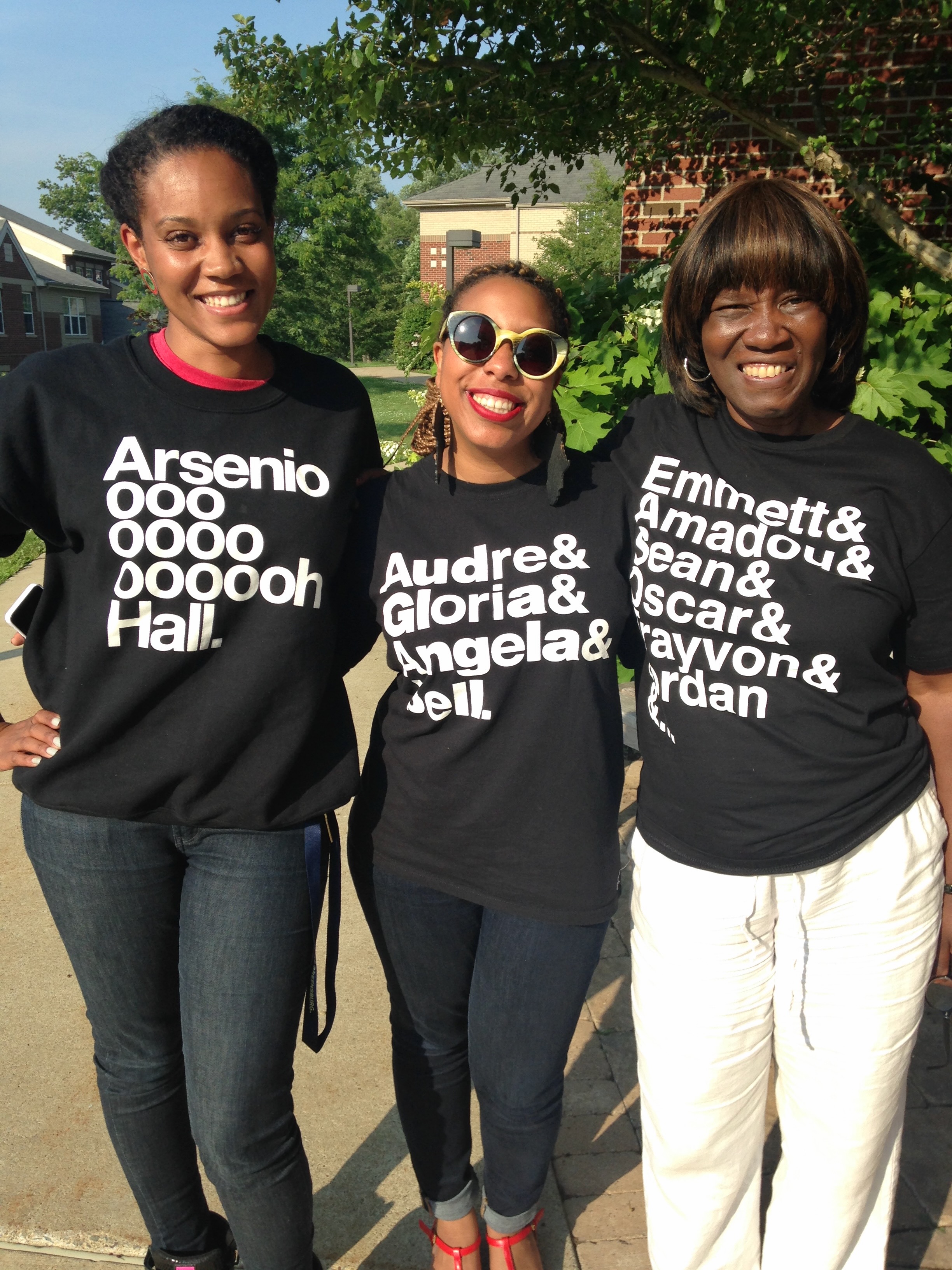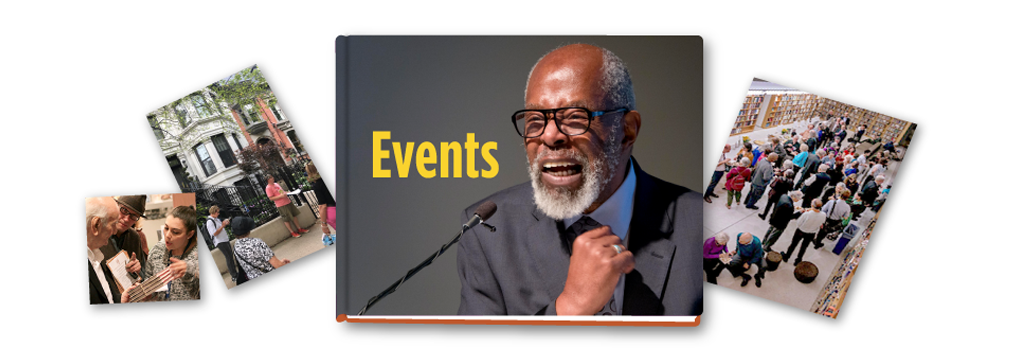“There is nothing that can’t become a poem”: The Work of Patricia Smith
Wednesday, July 10, 2024
by Barbara Egel
I couldn’t stop writing.
I wrote myself angled and tress-topped
I wrote myself hero, I wrote myself white,
Cherokee, cheerleader, distressed damsel in Alan Ladd’s arms,
I wrote myself winged, worshipped.
– “Related to the Buttercup, Blooms in Spring”
In this poem from her 2006 collection, Teahouse of the Almighty, Patricia Smith falls desperately in love. She is a child in elementary school, and she meets the word “anemone” and is captivated thereafter by words and what they can do, how they feel on the tongue and flowing out of a pen. We are very lucky that she encountered “anemone” and “couldn’t stop writing” because we now have so much of that writing to educate and discomfit us, to make us rage, to make us feel hot and bothered, to make us guffaw unexpectedly even as she refuses to let us turn away from hard truths.
 Patricia Smith started her professional life as a journalist, and that sensibility informs every stanza she writes as a poet. She has said many times that “the primary job of a poet is as witness,” and if you are privileged to read her poetry, you, too, become a witness. Whether writing about a Motown bop heard on the streets of Chicago’s West Side in the ‘60s or headline-making catastrophes, Smith keeps readers infused with the blood of a moment, shortening the distance between us and people we are usually prompted to see as other. She is a historian of both the times she lives in and her own growth as a poet. Read all of her work at once, as I just did, and you see her returning to key themes and topics, not only sharpening her own take on them but also requiring readers not to forget. It’s as if she’s saying, “You thought you were done reading about Emmett Till/Smokey Robinson/George W. Bush in these pages? We are not done with that story, and we never will be.”
Patricia Smith started her professional life as a journalist, and that sensibility informs every stanza she writes as a poet. She has said many times that “the primary job of a poet is as witness,” and if you are privileged to read her poetry, you, too, become a witness. Whether writing about a Motown bop heard on the streets of Chicago’s West Side in the ‘60s or headline-making catastrophes, Smith keeps readers infused with the blood of a moment, shortening the distance between us and people we are usually prompted to see as other. She is a historian of both the times she lives in and her own growth as a poet. Read all of her work at once, as I just did, and you see her returning to key themes and topics, not only sharpening her own take on them but also requiring readers not to forget. It’s as if she’s saying, “You thought you were done reading about Emmett Till/Smokey Robinson/George W. Bush in these pages? We are not done with that story, and we never will be.”
“[Poetry is] like a second throat; it’s another way to speak.”
Patricia Smith didn’t set out to be a poet. As she tells it, one evening a journalist friend invited her to a poetry event at a blues bar. She agreed to come along to “drink and laugh at the poets.” Instead, in a room with Gwendolyn Brooks herself in attendance, she fell in love with the power of spoken word poetry. She dove in and became a slam national champion several times over and found that the slam scene in Chicago was open to whatever approach, tactic, or technique told the story. In an interview with poet Lynn Thompson, Smith recalls that flexibility. “I think the early days of performance and poetry competitions, particularly in the hotbed of Chicago, just nixed any pesky boundaries when it came to creation. ... The goal was to disappear ourselves so that there was no boundary between the poet and the audience.” The habit of reaching for whatever tool of word, rhythm, voice, gesture, medium would deliver the greatest impact has stuck with her throughout her career, even as she moved to the page.
That move was prompted in the ‘90s by a question from Luis Rodriguez of Tia Chucha Press when he asked her whether she had a manuscript. (Her sage advice from this moment: “When someone asks you if you have a manuscript, say yes, and then go home and worry about it because you don’t have one.”) That first manuscript became Life According to Motown. She published a book a year for the next three years, bringing her spoken word magic to print and somehow being just as captivating without her actual voice behind the poems. Read “Skinhead” from Big Towns, Big Talk and then find her performance of it on YouTube. Both will leave you shattered.
But Smith wanted more tools to express her complex vision. She studied in the Stonecoast MFA program with master prosodist, Annie Finch, learning the connection between meter and meaning, finding new shapes for the stories she wanted to tell. “A poem,” she says in an interview with Saeed Jones in Poetry, “is sometimes asking for something you don’t yet know how to do. And you owe it to your poems to broaden your skill set.” Armed with the mechanics of sonnets, sestinas, villanelles, and other received forms, Smith produced Blood Dazzler as her MFA thesis. She says her MFA gave her “a sense of being part of that [poetic] lineage somehow—that was really empowering. Then I felt the books had more of a back to them. ... It’s so wonderful to have those things at your disposal and let the poem tell you what it needs.”
Now Smith is not only a poet but a teacher of poets, at City Colleges of New York, at Cave Canem, at StoryStudio here in Chicago, and most recently, at Princeton. The collection of awards won along the way would take up more page space than I have here. We are lucky that rising poets are being infused with her particular approaches to subject, audience, and voice, and that they are measuring themselves against the high standard she’s set. The bounty of Patricia Smith continues in books that don’t even bear her name on the cover.
“[Patricia Smith] demands that we understand our histories don’t just live in us; in fact, our histories have heat, and many of us are already on fire.” – Saeed Jones
The histories illuminated in Smith’s work are both the history of our country—those on fire and those choosing to ignore the smoke—and the history of Smith’s work as poet and witness. Smith is radical and political, not through declarations of dogma but through forcing readers to bear witness beside her. A Black woman poet from a Chicago neighborhood that has not gentrified in her lifetime, Smith is unapologetic about causing necessary discomfort. “I think a lot of white folks, in particular, come to my work looking to hear a Black person say that it’s OK not to pay attention.” Those white folks could not be more wrong. In her book, Gotta Go Gotta Flow, that pairs poems with Michael Abramson’s photos of South Side nightlife, Smith starts the closing essay with, “I’m black, so I can tell you and you can believe it. Here’s what happens when a white person walks (stumbles, strides, sashays, trudges, wanders, traipses) into one of our spaces.” She’s talking about physical spaces, but she might as well be talking about her poems, too.
A Black woman poet from a Chicago neighborhood that has not gentrified in her lifetime, Smith is unapologetic about causing necessary discomfort. “I think a lot of white folks, in particular, come to my work looking to hear a Black person say that it’s OK not to pay attention.” Those white folks could not be more wrong. In her book, Gotta Go Gotta Flow, that pairs poems with Michael Abramson’s photos of South Side nightlife, Smith starts the closing essay with, “I’m black, so I can tell you and you can believe it. Here’s what happens when a white person walks (stumbles, strides, sashays, trudges, wanders, traipses) into one of our spaces.” She’s talking about physical spaces, but she might as well be talking about her poems, too.
Smith’s wisdom as a poet overcomes the difficulty of writing so that a poem both speaks truth and holds the attention of those whose first impulse is to look away from that truth. Her prime directive: find the unexpected approach. In an interview, she says, “A lot of the research is: What has no one heard? What has no one read? What’s a detail that might be on the periphery of the story? That’s a great entry point. You’re trying to upend expectations for the poem, from both the reader and from yourself.” This is why even in her mood-setting Motown poems, there’s more attention paid to Florence Ballard than Diana Ross, why the story of a made-up mutt in Blood Dazzler can have you on the edge of your seat even as you know his fate, why a persona poem that gives you Olive Oyl’s origin story can make you cry.
Smith’s focus on emotional truth also means she’s a practitioner of close- up magic. I dare you to find a broad generalization anywhere in her pages. Instead, we can smell the heat of the asphalt as the double-dutch ropes hit it, feel the itch of the polyester dress, taste the sour pickle pierced by a peppermint stick (swear to god, that’s a thing). When it comes to bodies and everything they do, Smith is necessarily relentless. “What You Pray Toward” explicates the orgasm, the body’s needs and capacities. Many of her poems, leading up to and including Shoulda Been Jimi Savannah, argue the quirks of bodies and what to do with them from hair to heels. The poem “34” in Blood Dazzler cements the memory of the thirty-four bodies found at a nursing home near New Orleans where Katrina’s floodwaters overwhelmed the building. Choosing taste as the primary sense in stanza four is both an unexpected approach and an example of how sensory detail pins the reader to the page.
If you knew my alley, it’s stink and blue,
if you knew dirt-gritted collard greens
salt-pork slick and doused with Tabasco,
then you knew me.
I know that you’ve come
with my engine, and the rest of my skin.
You will rise me.
Smith has stated that her purpose in this is at least in part to keep historical events alive and in the forefront of memory. In an interview with Joseph Ross, she recalls a moment when she read from Blood Dazzler and realized that the children in front of her didn’t know about Hurricane Katrina, so “[Poets are] basically teaching what the history books that go into schools aren’t teaching.” She preserves the culture of Madison Street in defiance of the crime statistics with which the media defines the neighborhood. The crash of United flight 232 happened within my conscious lifetime, but I had to google the details when reading “Mayday” because the event, which dominated the news for weeks and changed the aviation industry, had slipped from memory. Will people a generation from now know the name of Rekia Boyd? Sandra Bland? They will because Patricia Smith has captured them and made them eternally important, eternally voiced.
“If you don’t tell your story, someone else will.”
 Smith’s sense of history is pegged to her own history. Shoulda Been Jimi Savannah is the book that chronicles the growing up of Patricia Smith. Jimi Savannah captures not just the story of a girl raised in a house with a disappointed mother and a loving father who couldn’t stay faithful, a girl who is too good in school and not quite good enough at school dances, a girl who sees and remembers what passes right by most people in the dailiness of growing up. Smith’s parents came up from the south as part of the Great Migration, but like a lot of immigrants, they didn’t know how to teach their city-born daughter what she needed to learn. Even when Smith directly asked her mother about her Alabama childhood, the reply was, “Girl, why you wanna know about all that country stuff? We’re better than that now.” As Smith says, “A lot is written about that generation, but not much about that first confounded group of city- dwellers, children whose parents had traded creeks and front porches for fire hydrants and tenements.” “True That” a short, pointed poem in a book full of long, lush narratives and descriptions, captures that confusion.
Smith’s sense of history is pegged to her own history. Shoulda Been Jimi Savannah is the book that chronicles the growing up of Patricia Smith. Jimi Savannah captures not just the story of a girl raised in a house with a disappointed mother and a loving father who couldn’t stay faithful, a girl who is too good in school and not quite good enough at school dances, a girl who sees and remembers what passes right by most people in the dailiness of growing up. Smith’s parents came up from the south as part of the Great Migration, but like a lot of immigrants, they didn’t know how to teach their city-born daughter what she needed to learn. Even when Smith directly asked her mother about her Alabama childhood, the reply was, “Girl, why you wanna know about all that country stuff? We’re better than that now.” As Smith says, “A lot is written about that generation, but not much about that first confounded group of city- dwellers, children whose parents had traded creeks and front porches for fire hydrants and tenements.” “True That” a short, pointed poem in a book full of long, lush narratives and descriptions, captures that confusion.
In my neighborhood
I got jumped
because my daddy lived at home.
Then,
when he didn’t live at home anymore,
I got jumped
because he had the nerve
to visit.
A huge part of the story of Patricia Smith is soundtracked by Motown. Her first book is called Life According to Motown, and throughout her books, the music and the artists recur. Motown isn’t just music for Smith, it’s a metonym of the sensuality, terror, and joy of adolescence: the thrill of fandom and the blush of fantasy. Motown is sensation: Fontella Bass shows up in a few poems, and you taste the sparkling/sour of her hit, “Rescue Me” and the brass lozenge of her name on your tongue. “Motown Crown” is a crown of sonnets, each poem focusing on a different artist. Smith uses juxtaposition to show, among other insights, the clash of glamour and talent. A poem about idolizing Diana Ross hinges into a sonnet about Mary Wells: all talent, little glamour.
But Mary Wells, so drained of self-esteem,
was a pudgy, barstool-ridin’ bucktoothed dream
who none of us would dare to idolize
out loud. She had our nightmares memorized
and like or like it not, she wailed our theme
while her too-blackness made us ill at ease
...
When Mary’s My Guy blared, we didn’t think race,
cause there was all that romance, and the keys
that Motown held. Unlocked, we’d soon ignite.
We stockpiled extra sequins, just in case.
“I’m trying to take the reader through the experience of a mother.”
But that West Side childhood also introduced the themes that underpin nearly all of Smith’s writing, even the funny ones: the violence of communities struggling to make a new northern history out of scraps and anger, the violence of indifference from the dominant white culture that easily turns away from stories and toward statistics to feel better about itself, the violence of loving someone wholly knowing that skin color and zip code lengthen the odds of that love having the luxury of a whole lifetime. These themes play out in all of Smith’s books, but Close to Death and the even darker and tighter Incendiary Art lock onto readers like handcuffs, pinning us to the moment and leaving marks when we’re released. These books are ostensibly about how America sees young Black men as disposable and interchangeable, which (as white America intends?) leads them to see themselves that way, too. In her introduction, Smith writes that young Black men are wearing clothes emblazoned with “C2D” or “close to death” because “so many of them are.” For all the poems about the young men themselves, two other often ignored constituencies come into the frame in these books: Black men who have made it to old age and who don’t seem to be grounded in how to be old because it’s so unexpected (see “Waiting for Louis to Spill the Beans” in Close to Death), and the mothers of these men.
stories and toward statistics to feel better about itself, the violence of loving someone wholly knowing that skin color and zip code lengthen the odds of that love having the luxury of a whole lifetime. These themes play out in all of Smith’s books, but Close to Death and the even darker and tighter Incendiary Art lock onto readers like handcuffs, pinning us to the moment and leaving marks when we’re released. These books are ostensibly about how America sees young Black men as disposable and interchangeable, which (as white America intends?) leads them to see themselves that way, too. In her introduction, Smith writes that young Black men are wearing clothes emblazoned with “C2D” or “close to death” because “so many of them are.” For all the poems about the young men themselves, two other often ignored constituencies come into the frame in these books: Black men who have made it to old age and who don’t seem to be grounded in how to be old because it’s so unexpected (see “Waiting for Louis to Spill the Beans” in Close to Death), and the mothers of these men.
Smith’s unexpected entry point, her way of circumventing the anonymization of countless murdered Black men, is through their mothers, for whom each dead boy is an individual with a kindergarten school picture, a favorite food, a way of smiling that she will see until the day she dies. Smith notes that “in the case of the people that were lost, often at the hands of the police, the mother’s voice was the one that you didn’t hear often. You hear [her voice] twice: [She’s] at the beginning of the story when they tell her that her child is gone and then at the end when they say that the person responsible for her child’s death is not responsible. Then she goes away.” The poem, “Undertaker,” sits at the intersection of love and poverty as the undertaker of the title has to manage these women’s grief while also making a living.
I know that she has sold
everything she owns, that cousins and uncles
have emptied their empty bank accounts,
that she dreams of her baby
in tuxedoed satin, flawless in an open casket,
a cross or blood red rose tacked to his fingers
his halo set at a cocky angle.
I write a figure on a piece of paper
and push it across to her
while her chest heaves with hoping.
She stares at the number, pulls in
a slow weepy breath: “Jesus.”
Whether it’s the mother of a boy whose name you know--Emmett Till, Michael Brown, Rodney King--or a boy who represents multitudes that don’t make the news, Smith, by foregrounding the voice of the mothers, makes us unable to look away.
“The closer I can move the lens in, the bigger story I can tell.”
Smith has few rivals in her mastery of the persona poem as a vehicle for bearing witness. In a video conversation with Tyehimba Jess, Smith notes that “in  slam, you’re working on both your inner and your outer voice.” In her persona poems, Smith intensifies that inner/outer tension by considering subjects where the only hard evidence is the outside—a news story, a daguerreotype, a funeral notice—and from that, creating a fully realized life and voice that hews to its emotional truth, somehow being wholly made up and unassailable fact at the same time. The biggest story Smith has told is in Blood Dazzler, which is about the people in and around New Orleans at the time of Hurricane Katrina. The multitude of voices is breathtaking. One example: M’Dear is a woman who has to evacuate, leaving her dog, Luther B, behind to fend for himself. Luther B appears in five poems, and our investment in his survival grows with each one, even as we know Smith won’t lie to us and say he made it. First, M’Dear reassures herself that he’ll be okay: “Tie Luther B to that cypress. He gon’ be all right. / That dog done been rained on before.” As the water rises, her assurances that he’ll weather the storm take on the quality of prayer. At the end, Luther B is alone, ascending and free from his tired, muddy body. Only because M’Dear’s voice is so close-in and the details are so clear—the porch, the can of Alpo, M’Dear’s assertion that nobody needs to worry about the dog because “He harder to shake than a bucktoothed man”— does Smith avoid letting us off the hook. “The dog dies” is a clichéd conduit for cheap emotional release. “The woman who loved the dog and whom nobody would look at twice on the street worries herself to tatters over him even as her own life is in danger,” that’s a story you can’t back away from.
slam, you’re working on both your inner and your outer voice.” In her persona poems, Smith intensifies that inner/outer tension by considering subjects where the only hard evidence is the outside—a news story, a daguerreotype, a funeral notice—and from that, creating a fully realized life and voice that hews to its emotional truth, somehow being wholly made up and unassailable fact at the same time. The biggest story Smith has told is in Blood Dazzler, which is about the people in and around New Orleans at the time of Hurricane Katrina. The multitude of voices is breathtaking. One example: M’Dear is a woman who has to evacuate, leaving her dog, Luther B, behind to fend for himself. Luther B appears in five poems, and our investment in his survival grows with each one, even as we know Smith won’t lie to us and say he made it. First, M’Dear reassures herself that he’ll be okay: “Tie Luther B to that cypress. He gon’ be all right. / That dog done been rained on before.” As the water rises, her assurances that he’ll weather the storm take on the quality of prayer. At the end, Luther B is alone, ascending and free from his tired, muddy body. Only because M’Dear’s voice is so close-in and the details are so clear—the porch, the can of Alpo, M’Dear’s assertion that nobody needs to worry about the dog because “He harder to shake than a bucktoothed man”— does Smith avoid letting us off the hook. “The dog dies” is a clichéd conduit for cheap emotional release. “The woman who loved the dog and whom nobody would look at twice on the street worries herself to tatters over him even as her own life is in danger,” that’s a story you can’t back away from.
The biggest voice in the book is that of Katrina herself. She feels herself coalescing into a storm and then growing, stoking her appetite on the Gulf and then coming in to devour the city. The Katrina-voiced poems each start with a weather update from a specific day in 2005. In “5 p.m. Thursday, August 25, 2005,” the storm talks about her appetite:
My eye takes in so much—
what it craves, what I never hoped to see.
It doesn’t care about pain, is eons away
from the ego’s thump, doesn’t hesitate
to scan the star, adjust for distance,
unravel the world for no reason at all, except that it
hungers.
Through Katrina’s voice, it becomes clear that a storm is a storm, neither good nor evil no matter how devastating its effects. What the rest of the book demonstrates is that the evil visited upon the city emanated, not from the storm, but from the people who were supposed to help, to manage, to prevent death. A poem in the voice of FEMA director Michael Brown is chilling, and another in the anonymous voices of middle-class white people inconvenienced by the storm on their way out of town exemplifies the literal short-sightedness of those who have never had to see beyond their own neighborhoods. Smith’s point in this book is to keep Katrina and its victims and survivors always in our sightlines, always a necessary irritation of conscience that keeps our lens focused where it ought to be.
Smith’s point in this book is to keep Katrina and its victims and survivors always in our sightlines, always a necessary irritation of conscience that keeps our lens focused where it ought to be.
And speaking of lenses, in her most recent book, Unshuttered, Smith zooms all the way in on photo portraits she’s collected from the 19th and early 20th centuries, photos of African Americans who saved up to sit stiffly in photo studios from Maine to Montgomery and all points in between. These photos bear no names, and Smith simply numbers the poems, sometimes leaving the subjects nameless and sometimes weaving names into the narrative. At most, these portraits are in cardboard frames bearing the name and location of the studio at which they were taken. Many do not have even that much information.
The pictures ended up at flea markets, resale shops, and garage sales, out of the hands of family who could have identified the ancestor in the shot. Smith gives each of them a poem, an identity, using just a facial expression, a strip of lace on a blouse, the juxtaposition of people in the frame. It is a bold move, and it’s clear that she takes the responsibility of these anonymous lives very seriously.
In some of the photos, Smith has used the location of the studio to connect the photo with a larger history of the place. A man and a young woman become in the poem father and daughter during the Memphis yellow fever outbreak of 1878. The man is a doctor and tells the story of his daughter’s dwindling away with disease, the disconnection left in the family after her passing. Does Smith tell a verifiable story? Of course not. Does she tell a story that might have happened and been lost in the panic, the resistance against remembering, the fact that, as the father says, “we were taught to rely on dying” and so have no need to inform the living? Absolutely. (It reinforces a lot of Smith’s larger history that looking up “Wytheville, VA, lynching” in order to give context to poem 31 yielded not one but two news stories of men lynched in that town, four decades apart.)
Sometimes, the truth Smith finds in a poem is shocking, as in poem 16. The accompanying photo is of a serious looking young woman, bespectacled, hair frizzing out of any shape she might have tried to impose on it. Compared with the women in other photos in the book, she looks a bit haphazard, as though she didn’t have time for careful preparation for her sitting. Then comes the poem, and we learn that she’s something of an amateur at being a woman. I will give away the second stanza, but I know you’ll go back and read the whole poem.
Tell me that I have earned at least this much woman. Tell me
that this day is worth all the nights I wished the muscle
of myself away. It will take my mother less than a second to know
her only child, her boisterous boy, steady, pounding at his
shadow to make it new. Here I am, Mama, vexing your savior,
barely alive beneath face powder and wild prayer. Here I am,
both your daughter and your son, stinking of violet water.
After the poem, you look back at the picture and see a serious young man struggling with who he is and who he’s been taught to be, the wild-minded hair, the searching expression, the lack of feminine wiles. The formerly living, breathing young woman in the picture is ninety-nine percent likely to have been born female, but Smith’s description, her ability to get beneath the skin of the photo, makes us believe in her possibility just as strongly.
“Take something beautiful and add some sort of cacophony to it.”
 Smith’s early poems tie the techniques of spoken word to the page—the oral paradiddle of alliteration and assonance, the stretch of slang and West Side vernacular adding length to words, the fermata and drop in the line break, “Hallelujah for grizzled lip, snuff chew, bended slow walk, / and shit talkin’.” But the understanding of form and meter she added to her toolbox with Blood Dazzler really shows her virtuosity. The spoken word artist and the formalist living in one poetic sensibility do spectacular things on the page. Richard Wilbur said of poetic form that “Limitation makes for power: the strength of the genie comes of his being confined in a bottle,” and Smith’s deft touch with a variety of received forms from the centuries-old—such as sonnets, sestinas, villanelles—to the newly invented, like Terrance Hayes’s golden shovel, embodies that power. But Smith’s strength is not that of a legalistic, masculine genie crammed willy-nilly into a container. A better metaphor is that when Smith uses those forms, it’s like a woman’s body with generous curves laced into a corset: the shape hews to convention even more than when it’s naked, but somehow the individual sensuality is heightened, and you sweat. It’s more seductive for being wrapped.
Smith’s early poems tie the techniques of spoken word to the page—the oral paradiddle of alliteration and assonance, the stretch of slang and West Side vernacular adding length to words, the fermata and drop in the line break, “Hallelujah for grizzled lip, snuff chew, bended slow walk, / and shit talkin’.” But the understanding of form and meter she added to her toolbox with Blood Dazzler really shows her virtuosity. The spoken word artist and the formalist living in one poetic sensibility do spectacular things on the page. Richard Wilbur said of poetic form that “Limitation makes for power: the strength of the genie comes of his being confined in a bottle,” and Smith’s deft touch with a variety of received forms from the centuries-old—such as sonnets, sestinas, villanelles—to the newly invented, like Terrance Hayes’s golden shovel, embodies that power. But Smith’s strength is not that of a legalistic, masculine genie crammed willy-nilly into a container. A better metaphor is that when Smith uses those forms, it’s like a woman’s body with generous curves laced into a corset: the shape hews to convention even more than when it’s naked, but somehow the individual sensuality is heightened, and you sweat. It’s more seductive for being wrapped.
Too often, formal poets are so mesmerized by the ka-THUNK ka-THUNK of the iamb that they give it too much leeway to make itself the star of the show. But when someone like Smith, who started with “anemone” in her mouth, who made Green Mill audiences cry, cackle, come with nothing but a mic in her hand, decides to write a sonnet, that sonnet is packed—a crust just sturdy enough to hold almost more fruit and spice than your mouth can handle. The final sonnet of the “Emmett Till: Choose Your Own Adventure” poems in Incendiary Art demonstrates what I mean. On first reading, you almost miss the sonnet-ness of it because the sounds seduce you, and the story of the boy whose picture was splashed on every newspaper draws you in; the rattlesnake temptation of the last two lines gets into your blood. Later, you notice the flawless Shakespearean rhyme scheme. The iambic pentameter ebbs and flows but doesn’t crack; the enjambments keep it from becoming stodgy and slowing the poem. She has the confidence to move the turn a line later than usual, which is where this poem needs it to be. Then that gut-shot of a final couplet does what would make centuries of sonneteers shout. Here it is:
So our Chicago kid runs by the store
instead of being wooed by chewing gum
And peppermints. The steamy shop’s a bore
‘cause they’ve got better suckers where he’s from.
He’s sworn to be remembered in this town,
and so his raucous cousins egg him on
to escapades much sweeter than those found
in candy—live and buzzing skins upon
the water, fruit to yank from every tree.
He hurtles past without a second thought,
without acknowledging her silent plea
behind the screen, her gaze so clearly fraught
with crave. Hey nigger, welcome to the South—
come slip my sugar deep into your mouth.
Sonnets are love poems, sure, but they are also rhetorically sophisticated arguments, and Smith has, in these alternate realities of Emmett Till’s life, made those arguments without desiccating the power of the story. In all her forms (see also “Hip-Hop Ghazal” and “Ethel’s Sestina” among many others), the spoken word artist seduces the formalist and produces structure and sensuality in the same lines.
It feels almost premature to grant Patricia Smith a lifetime achievement award such as the Fuller because there is so much more for her to do, so many more stories that need her particular way into them. Go back to the early books for the spoken-word seductress and then move forward into the eye of the meaning-making, the witnessing that she has made her work.
Barbara Egel is a poet and critic whose day job is as co-director of Design Thinking and Communication at Northwestern. She has been a Chicago Literary Hall of Fame board member since 2021.








